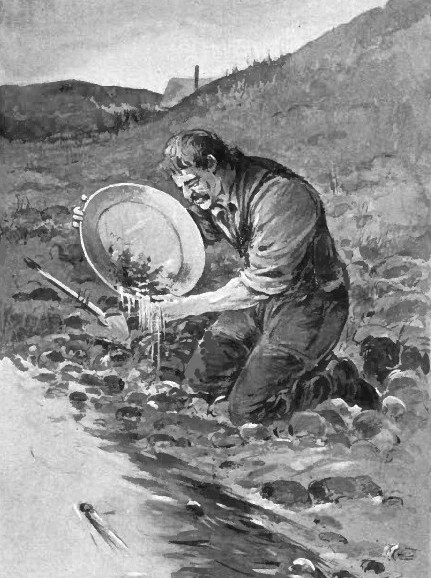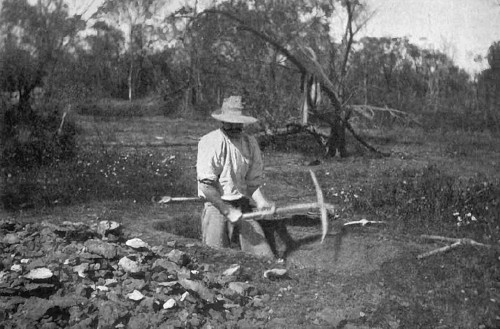One of the greatest drawbacks to prospecting in the North is the dense growths of moss and forest that cover the ground. In most of the Western states, in South Africa, and in Australia this drawback does not exist and prospecting was by that much the easier. However, as a compensation, there is abundant water in Alaska and the Northwest, while it was and is almost entirely absent in several other regions that possess immense bodies of ore which are not available for this very reason. Quartz has been called the mother of gold, and certainly quartz and gold are inseparably connected today. As to where gold may be found the best reply that can be given is in the words of the old miner, who, when asked that question, said: "Where it be's; there it be's," and then added, "and there I’ve been."
Although most prospectors travel alone from sheer necessity, there can be no doubt that three or four men forming a party and working together have the advantage. They can do their work cheaper, more thoroughly, and more surely. By co-operating they may carry a more complete outfit. Should any accident happen help is at hand, whereas the solitary wanderer often dies as the result of some accident that would have been trivial had he had a companion. Three or four claims may be worked in conjunction with one another at far less proportionate expense than a single one could.
Nature's preparation for the reception of great ore deposits is somewhat as follows: The crust of the earth is prepared for the reception of the metals by great outbursts of igneous or melted rocks ; the metals themselves being carried in suspension in the heated water that everywhere traverses the strata. These metals are deposited in the veins as soon as the waters begin to cool, and the pressure to which they were subjected from deep down in the earth's crust is removed. A great mineral country is usually marked by the outcrops of the veins being persistent in their courses and traceable for many miles, though very probably many breaks may occur in these outcrops. The rocks associated with great ore bodies are lime, porphyry, granite, shales, slates, quartzites, and diabase. Fragments of mineral and gangue, known to the miners as float, may be littered over the hills and encumber the courses of the stream. A central line of eruption may often be traced by masses of altered rock, and beds of lava or other volcanic products. We find the granite has been melted and the limestone has acquired magnesia, and thus become dolomatized.
Whenever a heavy deposit of pyrites, or mundic, is found mineral probably exists below. The cubes of pyrite are not always valueless, they may contain gold in addition to the iron and sulfur. When the pyrites decay under the influence of the weather, and leave the quartz honeycombed, these cavities often contain concentrated gold; for which reason you often get a higher assay from the surface than from any point lower down in the vein. In sinking the shaft soon gets below this altered quartz and the ores are then combined with sulfur. They have become sulfides, and are harder to treat. The prospector should therefore act very cautiously when trying to develop a mine with a small capital behind him; because, although the first ore may be adapted for stamping, he may find, before he has gone down fifty feet, that it can only be treated in a smelter, and that all the money he has put into crushing apparatus is wasted.
Without the prospector there would be no mining and the world would yet be in the stone age. He is not appreciated at anything like his real worth. He requires ability and experience, push and perseverance. Prospecting is a search for valuable minerals. He may not be very deeply learned in either geology or mineralogy, but he must have a keen eye and good natural powers of observation. There are some sixty or seventy elements in the world, and the most common is oxygen. Nearly all the coloring matter of rocks comes from iron. Wind, frost, rain, snow, and heat, cause a crumbling of the different rocks, and running water wears them away, and carries off and distributes the particles. By this agency, and by floating ice, they are often removed to long distances. The action of internal heat renews the deposits of mineral by eruption, or by hot springs, but this means of renewal was much more powerful in the past than it is now. Organic matter found in the crust of the earth was derived from animals or vegetables. Coal is a legacy from forests that flourished ages ago, while petroleum is all that remains of vast schools of fishes that swarmed in Devonian seas. Stratified rocks are either sand, clay, or calcareous, which means lime-bearing. In their natural position they were horizontal, but owing to subsequent volcanic action they are, in some localities, tilted at all conceivable angles. The eruptive rocks have burst through them in places, changed their character, divided them by intrusive masses, and generally enriched them with mineral deposits.
Everything now known points to the theory that the contents of veins were deposited in the lodes by infiltration. In a few instances famous mines have no veins, but are literally hills of mineral; they are then of low grade, but much more remunerative than average high grade mines, owing the vast quantity of ore, and the ease with which it can be mined. The famous Treadwell mine, on Douglas Island, Alaska, has ore that is worth less than four dollars a ton, but it is quarried, and 640 stamps work day and night. There is about a dollar a ton profit, and hundreds of thousands of tons are treated annually. The tin mine known as Mount Bischoff, in Tasmania, and the Burra copper mine in Australia are other instances. Each of these deposits was found as an outcropping on the bare top of a low hill, and none of them has walls. A fault may throw the vein up or down, and a good deal of exploration may have to be done before it is recovered.
A lenticular vein consists of a series of double pointed ore bodies like lenses which may be strung out, overlapping, or not. The outcrop of a vein is never the same as its strike, except on a level surface. A stringer of ore branching off from the main vein is known as a chute, shoot, or chimney. In developing a ledge or lode, first find out what the ore is. Gold is shown in the mortar, especially after roasting. Silver may be recognized at sight, or by assay tests, or blow pipe ; copper, by its vivid colors. green or blue for carbonate and red for oxide or metallic copper. The ore often differs in various parts of the vein. Explore your lode along the surface. across, and down its dip. When you find it continuous it will be time enough to think of a vertical shaft. The top of a shaft must be timbered with logs, so as to give sufficient fall to get rid of the mineral when it is hoisted. The first thing the prospector has to consider is his outfit. The more complete this is the better, but ninety-nine times out of a hundred the difficulties of transportation in a wild region are so enormous that he will have to do without a great many things that he would like to have. He must endeavor to make up for the lack of tools by ingenuity ; then he may get along fairly well. A pan, he must have. In this he will wash carefully all his samples. Then, a flask of quicksilver is more precious to him even than gold; for, having it, he can resort to pan-amalgamation, which will save the precious metal even when it is in minute particles. This process may be described as follows : A pound or two of the ore in powder is placed in the pan and water is added until the mass becomes a thin pulp.
One ounce of quicksilver and a small piece of that deadly poison, known to the chemist as cyanide of potash, and as prussic acid to the ordinary man, should be added, and the mass should be stirred thoroughly, for two hours if you can stand it. Then turn in water and wash off the dirt and the amalgam will be found in the bottom of the pan. This you must collect very carefully. You should have a square piece of chamois skin or a piece of strong white cotton cloth. In either case the amalgam is put in the center of this square and the cloth twisted until all the superfluous quicksilver is pressed out and your amalgam remains nearly free from mercury. This amalgam placed on a shovel and held over a brisk fire will soon show the yellow color of gold. If you have no mould you may make one of clay, put your gold therein with a little borax, and very soon, the fire being hot enough, you will have a tiny ingot of the precious metal. But most prospectors are satisfied when they have obtained their sponge gold, and do not carry their operations further in these rough and ready tests.
Continue on to:
The Basics of
Hard Rock Prospecting, Part 3
Return To:
Gold and Silver Prospecting Basics


